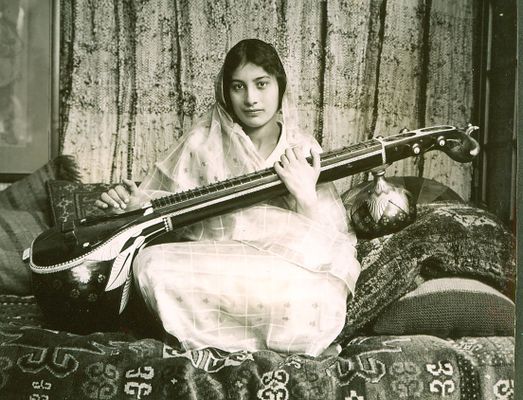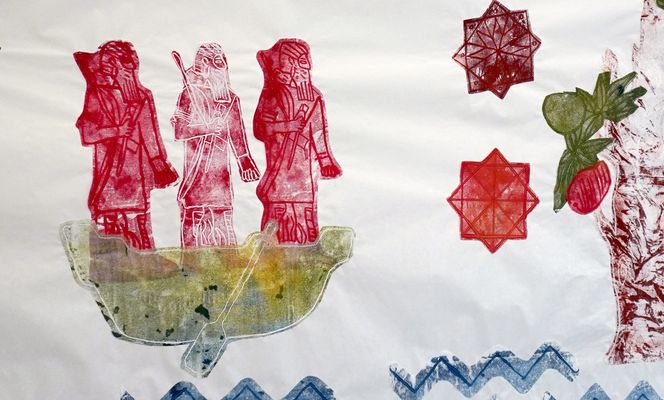Bust of Noor Inayat Khan
Karen Newman, 2012Noor Inayat Khan was the first woman agent to be dropped behind enemy lines in France during the Second World War. She joined the Women’s Auxiliary Air Force and trained as a radio operator early in the war. In 1942, the Special Operations Executive recruited Noor as a radio operator and spy. After completing training in June 1943, she was dropped into France to work with the Resistance in Paris. Although Noor evaded capture and continued to send secret messages back to London for months, she was eventually arrested by German forces. After ten months in prison, Noor was sent to Dachau concentration camp and executed in September 1944, aged just 30.
The Noor Inayat Khan bust is part of RePresenting Bloomsbury
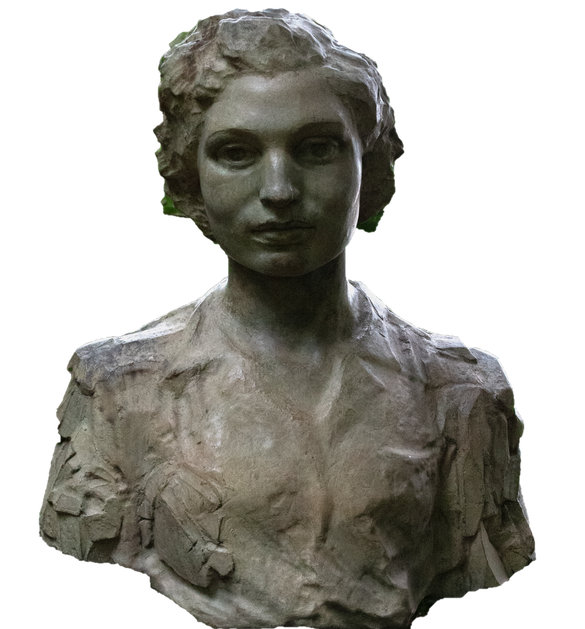
Noor Inayat Khan was the first woman agent to be dropped behind enemy lines in France during the Second World War. She joined the Women’s Auxiliary Air Force and trained as a radio operator early in the war. In 1942, the Special Operations Executive recruited Noor as a radio operator and spy. After completing training in June 1943, she was dropped into France to work with the Resistance in Paris. Although Noor evaded capture and continued to send secret messages back to London for months, she was eventually arrested by German forces. After ten months in prison, Noor was sent to Dachau concentration camp and executed in September 1944, aged just 30.
The Noor Inayat Khan bust is part of RePresenting Bloomsbury


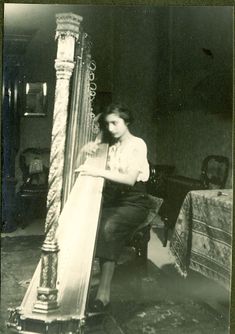

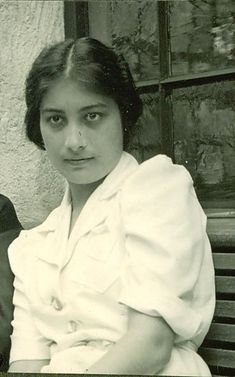
About Noor Inayat Khan
Noor-un-Nisa Inayat Khan was born in Moscow in 1914. Her mother was a poet called Ora Ray Baker. In 1913 Ora married Noor’s father, Hazrat Inayat Khan, and took the name ‘Ameena Begum’. Noor’s father worked as a musicology professor, poet and philosopher. Her father was descended from Tipu Sultan, known as the ‘Tiger of Mysore’. He was the ruler of the Kingdom of Mysore, South India in the late 1700s and is known for his long standing opposition to British colonialism.
Noor’s parents were a huge influence on her. Her father was a teacher of Sufism which is a mystical Islamic belief and practice, seeking to find the truth of divine love and knowledge through direct personal experience of God. It focuses on the rejection of worldly possessions, purification of the soul and spiritual learning (tariqa). Her father’s teachings and beliefs had a profound effect on Noor’s life and strengthened her belief in pacifism.
The family lived in Paris in the 1920s and 1930s where Noor learnt fluent French and was very musical. She studied Child Psychology at the Sorbonne, University of Paris and was awarded a degree in 1938. She wrote children’s stories and her collection of legends based on the former lives of the Buddha, Twenty Jakata Tales, was published in 1939. Her stories centre on moral stories of sacrifice, spirituality and community and also include The Monkey Bridge, The Two Pigs and King Akbar’s Daughter.
Noor and the Second World War
When the Second World War broke out, Noor and her family escaped Paris to London where she joined the Women’s Auxiliary Air Force (WAAF). She thought deeply about what joining the WAAF meant for her commitment to pacifism, but felt that she needed to actively work towards ending Fascism and the Nazis. Her brother told her “how can we preach spiritual morality without participating in preventive action? Can we stand by and just watch what the Nazis are doing?” (Basu, Shrabani, 2006. Spy Princess: The Life of Noor Inayat Khan).
In 1942 Noor was recruited by the Special Operations Executive (SOE), a secret war time organisation set up to aid resistance in occupied Europe through spying, sabotage and subversion. Noor went through intensive, physically demanding training and was the first female agent to be sent for special radio operation training. She learnt to send coded messages and how use and repair radios.
In June 1943 she was the first female radio operator to be dropped behind enemy lines into occupied France, where she joined a network of agents and Resistance fighters in Paris. Her cover story was that she was a nurse called Jeanne-Marie Renier. Noor’s job was a very dangerous one and radio operators had a life expectancy of only six weeks. Using the code name ‘Madeleine’ she sent messages by radio transmission between the resistance network and London. These covert messages identified Nazi activity, targets and instructions for sabotage. Despite Noor’s network ‘Prosper’ being uncovered and agents arrested, she decided to stay in Paris. For over four months she continued to receive radio messages and aid the Resistance, but was finally betrayed and captured by the Gestapo in October 1943.
Noor attempted to escape several times and so was transported to Pforzheim prison in Germany for ‘safe custody’. At the prison her ankles were chained and she was kept in solitary confinement. For ten months she was regularly tortured and interrogated by the Karlsruhe Gestapo but refused to give away any information. On 12 September 1944 she was taken to Dachau concentration camp with three other women and executed. It is said her final word was ‘Liberté’.
After her death, she was awarded both the Croix de Guerre by France and the George Cross by Great Britain – the highest civilian honours for heroism and bravery.
This bronze bust was made by the artist Karen Newman. It was unveiled on 8 November 2012 by HRH The Princess Royal. The bronze bust was commissioned by the Noor Inayat Khan Memorial Trust and is situated near her home from 1940 – 1943 at 1 Gordon Square, Bloomsbury.
Click on the link below to read a poem about Noor Inayat Khan by writer Bianca Manu
Community Voices
We worked with Camden communities and artists to explore Noor Inayat Khan. Together they made artworks and sound pieces informed by her life and work. These are presented below.
The Winch Women’s group and Parliament Hill School
Over the summer term 2023, artists Leila Dear and Dexter Orzsagh worked with a group of women at The Winch community hub, and students at Parliament Hill School. They explored the life and work of Noor Inayat Khan together and created new artworks in response.
Through a series of workshops, the participants embarked on a multifaceted journey to engage visually with Noor Inayat Khan's heroic narrative and literary work. They worked to fuse explorations of Sufi philosophy, global art history and their own personal narratives and concerns. Collectively, this creative collaboration not only paid homage to Noor Inayat Khan's legacy but sought to empower women of all ages to find their voices, explore cultural identities, and appreciate the beauty and complexity of traditional art forms and storytelling.
Leila and Dexter set out to work with the participants in ways which engage historical narrative and feminist concerns. The resulting artworks are the product of collaboration between women of different generations, cultures and religions, tapping into a spectrum of spiritual, mythological and folkloric sources. Through processes of printing, collage and pattern making, the communities involved have reinterpreted and reimagined the writings of Noor Inayat Khan to express their own thoughts, feelings and experiences.
The group also worked with a sound artist, Laura Owen, and they wanted to create a soundscape which incorporated each aspect of the art workshops. The audio piece (left) is set out into 3 parts: The Monkey Bridge story, Noor Inayat Khan’s story, and participants’ own responses to the story and workshops. The soundscape ends with a reading of a poem written by one participant called ‘The Sacrifice’ which references The Monkey Bridge story, and pairs this with how she identifies with the story as a mother, making sacrifices for her children in the way that the Monkey King made sacrifices for his children.
The Year 9 students at Parliament Hill school also worked with Laura. In this sound piece (left), the students talk about Noor’s life story, explain what they did in the workshops and what they enjoyed about taking part.
Supporters


